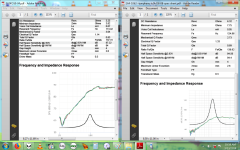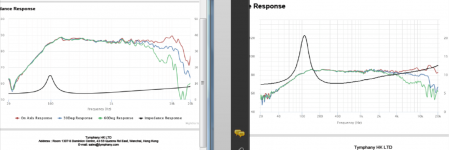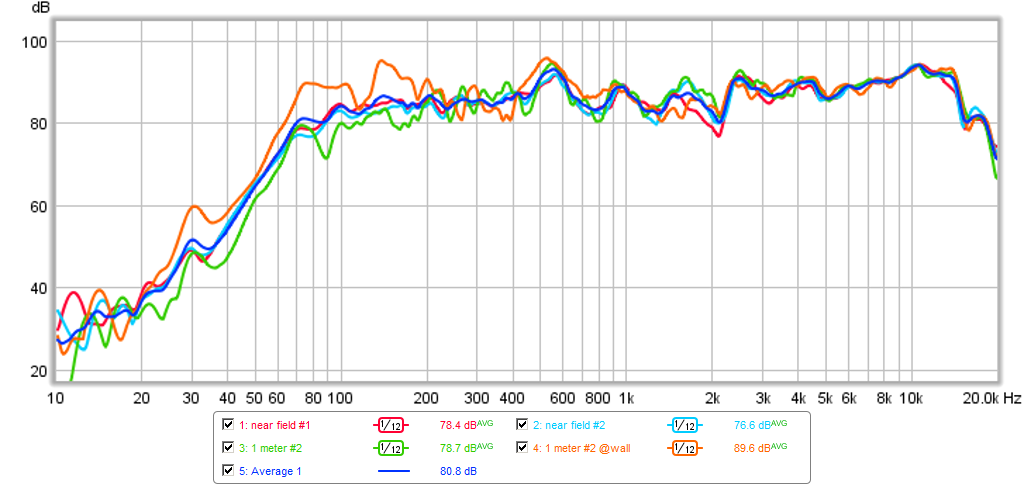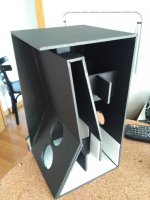Hello,
Troubles mounting the cabients...
I have cut every piece and everything fits perfect, but one thing... The lower 3FE25 hits the base with its back and it is impossible to fit it in its place! What do you recommend me, should I lower the bottom? Should I put the drivers a bit higher? Can I using some "circle adapter" put the drivers a bit more outside (it should be around 1cm)?
Help! I am completely new to this and I don't know what could cause any solution I have in mind...
Troubles mounting the cabients...
I have cut every piece and everything fits perfect, but one thing... The lower 3FE25 hits the base with its back and it is impossible to fit it in its place! What do you recommend me, should I lower the bottom? Should I put the drivers a bit higher? Can I using some "circle adapter" put the drivers a bit more outside (it should be around 1cm)?
Help! I am completely new to this and I don't know what could cause any solution I have in mind...
Is that from the plans I created? I didn't check that distance, I just centered them on the baffle. Moving them up on the baffle would be the best solution.
Yes MuddJester, I was using your plans, great work by the way! Everythings fits perfect.
I will put the drivers higher then, I will keep you informed
I will put the drivers higher then, I will keep you informed
Ok, sorry about that. Thanks for letting me know. I'm glad the rest of it worked for you. I'll try to update the plans with better driver positions. Please let us know what positions you end up using.
Ok, sorry about that. Thanks for letting me know. I'm glad the rest of it worked for you. I'll try to update the plans with better driver positions. Please let us know what positions you end up using.
I finally built one. Compared to the plans, I had put the lower driver 1cm higher (on the plane that it is mounted) and the upper driver 5,7mm. They are very close to each other, but there is no more space...
I have tested it a bit, I can not test two of them because of the changes in the drivers posititoning I run out of foam core and I can not buy more until monday. The test is completely human, no measures at all. How I tested it:
- Since the cabinet is not closed yet, it was lying on its side with heavy books closing the upper lateral
- The K apperture is badly holded in its place
- The audio source is a sansa clip through an old onkyo A-8015 that I recently bought and repaired
- To compare, I have used a logitech 2.1 X-210 plugged in the phone connector of the amplifier
- As I only have one karlsonator by now, the output is in mono
Personal impressions:
- Obviously the 2.1 has more bass power, however I think the karlsonator response is good, maybe complemented in the future with a subwoffer
- About the mids and highs... much much better in the karlsonator. The only I can say against the karlsonator is that sometimes the highs sound too bright, or crisp, I am not sure how to describe it...
And now, the questions for the experts:
About the bass, I think this kind of driver can not handle more bass, my impression could be "good but not awesome". Is it normal? Would it improve modifying the stuffing or after a proper closing?
And with the mids and highs, could it be because of the stuffing? should I add or remove? I put more dense stuffing on the upper part than in the lower, and some adhesive felt (white), a couple of pictures:
Attachments
Jiraiken,
Very nice work - looks beautifully made. I know the urge to hear it has you testing it without glue - but there are inevitable air leaks with that technique. A small pinhole leak will prevent the lowest bass notes from coming through. Hence reserve judgement until after it is glued and air tight. This is a ML TQWT transmission line. Kind of like a woodwind instrument. If you have ever played a flute or recorder you will know that having the smallest leak on one of the finger pads prevents the lowest note from being generated.
The brightness will be less with a K aperture and a BSC circuit as described by Skylar. Depending on placement you may or may not need he BSC.
Reduce the amount of stuffing from behind the drivers on out and up. Just a loosely stretched out ball of stuffing needs to be here to let the driver breathe. This will improve bass as well. Having an attached K aperture improves bass as well. So you have about 3 things that will all
Come together to improve the bass. Be patient.
Very nice work - looks beautifully made. I know the urge to hear it has you testing it without glue - but there are inevitable air leaks with that technique. A small pinhole leak will prevent the lowest bass notes from coming through. Hence reserve judgement until after it is glued and air tight. This is a ML TQWT transmission line. Kind of like a woodwind instrument. If you have ever played a flute or recorder you will know that having the smallest leak on one of the finger pads prevents the lowest note from being generated.
The brightness will be less with a K aperture and a BSC circuit as described by Skylar. Depending on placement you may or may not need he BSC.
Reduce the amount of stuffing from behind the drivers on out and up. Just a loosely stretched out ball of stuffing needs to be here to let the driver breathe. This will improve bass as well. Having an attached K aperture improves bass as well. So you have about 3 things that will all
Come together to improve the bass. Be patient.
Last edited:
There is a fourth thing that will improve bass: having the second speaker, and with both speakers placed optimally in the room.
For me that is about a meter or so away from the front wall and very importantly, a little toe-in will really improve the bass and soundstage. The toe-in trick I discovered a few months after completing my Karlsonators.
To get proper soundstage, and bass, the distance between the listener and either speaker should be roughly the same distance that the speakers are apart. That really works for me and it's the only way I listen now.
As a side note; Yesterday I had the opportunity to listen to Klipsch bookshelf speakers about the same size as my 0.53 K's. There is no comparison. The Karlsonators sound much, much better! Thanks for a wonderful speaker, X.
For me that is about a meter or so away from the front wall and very importantly, a little toe-in will really improve the bass and soundstage. The toe-in trick I discovered a few months after completing my Karlsonators.
To get proper soundstage, and bass, the distance between the listener and either speaker should be roughly the same distance that the speakers are apart. That really works for me and it's the only way I listen now.
As a side note; Yesterday I had the opportunity to listen to Klipsch bookshelf speakers about the same size as my 0.53 K's. There is no comparison. The Karlsonators sound much, much better! Thanks for a wonderful speaker, X.

It is hard to not test it before finishing... I will finish it and I will wait until I have the second one done to think about if I need a BSC.
About the positioning Skylar, the distance will be as you say but they will be close to the back wall... We'll se how they work together 🙂
Thanks for the advices!
About the positioning Skylar, the distance will be as you say but they will be close to the back wall... We'll se how they work together 🙂
Thanks for the advices!
As a side note; Yesterday I had the opportunity to listen to Klipsch bookshelf speakers about the same size as my 0.53 K's. There is no comparison. The Karlsonators sound much, much better! Thanks for a wonderful speaker, X.
You are most welcome Skylar!
What model Klipsch were you listening to?
TG9FD drop-in replacement for TC9FD ?
I've got the 4 ohm TG9s, are they a drop-in for the TC9s in all these great designs?

TG TC
Qts .83 .89
Qes 1.14 1.33
Qms 3.04 2.73
Fs 113 125
Vas 1.29 1.24

View attachment TG9FD10-04.pdf
View attachment -tc9fd18-08-spec-sheet.pdf
Great designs:
Designs for Vifa TC9FD Full Range Paper
MTM with TC9fd
Vifa TC9FD18-08 best bang for the buck
Any ideas for the VIFA TC9FD-18-08
Are those TC9FD?
FAST TC9FD DSP performace testing platform
MLTL using TC9FD and Pro audio 8?
Thanks and cheers,
Jeff
PS I've been enjoying them for a bit as desktop open baffle (Qt=.8) monitors and they're quite nice! 😀

I've got the 4 ohm TG9s, are they a drop-in for the TC9s in all these great designs?

TG TC
Qts .83 .89
Qes 1.14 1.33
Qms 3.04 2.73
Fs 113 125
Vas 1.29 1.24

View attachment TG9FD10-04.pdf
View attachment -tc9fd18-08-spec-sheet.pdf
Great designs:
Designs for Vifa TC9FD Full Range Paper
MTM with TC9fd
Vifa TC9FD18-08 best bang for the buck
Any ideas for the VIFA TC9FD-18-08
Are those TC9FD?
FAST TC9FD DSP performace testing platform
MLTL using TC9FD and Pro audio 8?
Thanks and cheers,
Jeff
PS I've been enjoying them for a bit as desktop open baffle (Qt=.8) monitors and they're quite nice! 😀

Last edited:
What model Klipsch were you listening to?
It was the Klipsch R15M driven by a Harman Kardon HK3770 and later I also listened to it driven by a Denon amp.
I've got the 4 ohm TG9s, are they a drop-in for the TC9s in all these great designs?
View attachment 671802
TG TC
Qts .83 .89
Qes 1.14 1.33
Qms 3.04 2.73
Fs 113 125
Vas 1.29 1.24
View attachment 671803
View attachment 671805
View attachment 671804
Great designs:
Designs for Vifa TC9FD Full Range Paper
MTM with TC9fd
Vifa TC9FD18-08 best bang for the buck
Any ideas for the VIFA TC9FD-18-08
Are those TC9FD?
FAST TC9FD DSP performace testing platform
MLTL using TC9FD and Pro audio 8?
Thanks and cheers,
Jeff
PS I've been enjoying them for a bit as desktop open baffle (Qt=.8) monitors and they're quite nice! 😀
View attachment 671810
Looks good to me, go for it. Only problem is the dual driver configs require a parallel connection so your amp needs to be 2ohm compatible.
🙂
You lose -6dB in sensirivity so now they are 79dB at 2.83v. Not so good. Better off with 8ohm TC9FD for $10 ea and get 92dB at 2.83v 4ohm.
I tried the TC9FD-8 in series. The voice coil inductance resulted in rolled off high freqs.
Because I had an amp that didn't like 4 ohm loads, I placed the drivers in parallel and added a 2 ohm resistor in series. Worked out just fine.
Because I had an amp that didn't like 4 ohm loads, I placed the drivers in parallel and added a 2 ohm resistor in series. Worked out just fine.
I tried the TC9FD-8 in series. The voice coil inductance resulted in rolled off high freqs.
Can you tell us how the roll off is? I'm in a similar situation (yet to build) and this is really interesting!
Not sure what I can tell you. I looked at the specs for the TC9FD; data sheet says Le=0.05 mH. Seemed like it was small enough that everything would be fine, as 0.05 mH in series with the TC9FD should produce a first order low pass with an F3 about 40,000 Hz. What I heard was a serious dent in the 8,000 to 16,000 Hz octave. Didn't bother to measure, as it was totally unsatisfactory. As I said, I went back & connected the drivers in parallel for better sound, and added a 2 ohm 12 watt Mills resistor so that my amp would be happy.
Cheers, Jim
Cheers, Jim
I have built a few 0.40x single driver Karlsonators, and I ran into two interesting problems.
1)
For the first build I used Visaton FRS8-8 which I had laying around, and it worked great at first. I was very suprised at how nearly monitor-like they sounded - very revealing! They didn't go as low as a wall-mounted MLTL (my first foamcore build), but the bass was flatter, they were much more neutral overall, and the only glaring problems were a few resonances in the mids probably caused by the aperture, that I EQd out and possibly could be fixed with some felt (and obviously not the best >10k treble).
However, the enclosure vibrated, a lot. It wasn't audible (possibly in harmonic distortion if you had anything to compare, but not any weird flexing sounds or stuff like that), but you could feel it with your hand even with low volume. I used 0.5 cm XPS without any paper backing, since that's the only thing that I can get "cheaply" around here (only about 3x the price of foamcore in the US), so I decided to take a bunch of white glue and some not too thin paper and glue about 2 layers of paper on the surface of the whole enclosure. It made the enclosure *a lot* stiffer and it also made it sound noticably worse. What I assume happened is that before reinforcing, the box had a low Q resonance in the lowest bass, while after reinforcing, both the resonant frequency and the Q factor moved up, so the speaker's corner frequency moved up and the bass that remained became overwhelming.
Seems like you want either a relatively soft cabinet or something as stiff as possible, but nothing in between. Maybe that's why people around here complain about their Karlsonators sounding boxy?
2)
For my second build I used a 3FE25, 4 ohm version. And it just sucked. I know they have a spike above 10 kHz, so overly sharp treble did not surprise me, but there was also no bass and the mid-treble seemed to be pretty bad as well, compared to the FRS8.
Since the 3FE25 is regarded as good around here, I did not expect this and assumed I did something wrong. I sliced the box open, resealed places where there could have theoretically been leaks, and closed it back again carefully, all using lots of hot melt. Then I built another box. Then I remembered that I'm using a TDA7297, which is rated for 8 ohm nominal, and although I was running them at very low volumes and the heatsink was not even warm, I tried running them in series in mono to increase the impedance.
Nothing really helped, so I assume they just don't work in a 0.40x Karlsonator. I realized that the 4, 8 and 16 ohm versions vary in some parameters - their Qts for example is 0.62, 0.7 and 0.82, respectively. I only know a bit of hornresp, so I can't simulate a Karlsonator, is it possible that those 3 versions are so different that some would work this badly?
Right now it seems that a FRS8 is surprisingly a much better choice for this particular box. In a few days I'll try a 3FE25-4 mltl (after simulating it in hornresp), and in about two weeks TC9FDs should arrive, so I'll see about those.
1)
For the first build I used Visaton FRS8-8 which I had laying around, and it worked great at first. I was very suprised at how nearly monitor-like they sounded - very revealing! They didn't go as low as a wall-mounted MLTL (my first foamcore build), but the bass was flatter, they were much more neutral overall, and the only glaring problems were a few resonances in the mids probably caused by the aperture, that I EQd out and possibly could be fixed with some felt (and obviously not the best >10k treble).
However, the enclosure vibrated, a lot. It wasn't audible (possibly in harmonic distortion if you had anything to compare, but not any weird flexing sounds or stuff like that), but you could feel it with your hand even with low volume. I used 0.5 cm XPS without any paper backing, since that's the only thing that I can get "cheaply" around here (only about 3x the price of foamcore in the US), so I decided to take a bunch of white glue and some not too thin paper and glue about 2 layers of paper on the surface of the whole enclosure. It made the enclosure *a lot* stiffer and it also made it sound noticably worse. What I assume happened is that before reinforcing, the box had a low Q resonance in the lowest bass, while after reinforcing, both the resonant frequency and the Q factor moved up, so the speaker's corner frequency moved up and the bass that remained became overwhelming.
Seems like you want either a relatively soft cabinet or something as stiff as possible, but nothing in between. Maybe that's why people around here complain about their Karlsonators sounding boxy?
2)
For my second build I used a 3FE25, 4 ohm version. And it just sucked. I know they have a spike above 10 kHz, so overly sharp treble did not surprise me, but there was also no bass and the mid-treble seemed to be pretty bad as well, compared to the FRS8.
Since the 3FE25 is regarded as good around here, I did not expect this and assumed I did something wrong. I sliced the box open, resealed places where there could have theoretically been leaks, and closed it back again carefully, all using lots of hot melt. Then I built another box. Then I remembered that I'm using a TDA7297, which is rated for 8 ohm nominal, and although I was running them at very low volumes and the heatsink was not even warm, I tried running them in series in mono to increase the impedance.
Nothing really helped, so I assume they just don't work in a 0.40x Karlsonator. I realized that the 4, 8 and 16 ohm versions vary in some parameters - their Qts for example is 0.62, 0.7 and 0.82, respectively. I only know a bit of hornresp, so I can't simulate a Karlsonator, is it possible that those 3 versions are so different that some would work this badly?
Right now it seems that a FRS8 is surprisingly a much better choice for this particular box. In a few days I'll try a 3FE25-4 mltl (after simulating it in hornresp), and in about two weeks TC9FDs should arrive, so I'll see about those.
I have 3FE25-4 in 0.40x and it is one of my best ( measurements on post 1 are that driver). The paper faced foamcore makes a difference. Use lots of bracing, line inside rear chamber with foam or felt. Nice deep bass, clear mids and highs, good balance.


- Home
- Loudspeakers
- Full Range
- Mini Karlsonator (0.53X) with Dual TC9FDs

